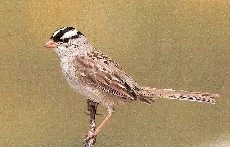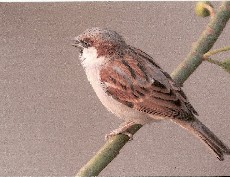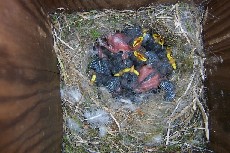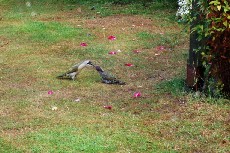| |
 
OUR CHANGING
BIRDLIFE
 |
|
I’m not a
twitcher, that is, someone who rushes all
over the country in search of some rare
bird that happens to have been blown to
our shores on an unusually strong wind,
but I do like to sit and watch them going
about their business. Earlier this year
we happened to be in the north of
Norfolk, wintering ground for the
thousand upon thousands of wild geese and
shore birds taking refuge from the Arctic
weather further north.
As it happened, the Arctic had come
to Norfolk as well, and added to that, a
ferocious Atlantic gale a few days
earlier had brought one of these
rarities, a American White-crowned
Sparrow, to the very village where we
were staying. Cue the
twitchers, in their hundreds when it
first arrived - only the fourth ever to
grace our shores. By the end
of the month the crowds had dwindled to a
dozen or so hardy souls, all hoping for a
glimpse of this grey little bird with
unusual markings on its head.
|
Of course, we never
saw it, though a few clicks on Google show that
plenty did. But it set me thinking
about our own Sparrow, and how rare that is
nowadays, in my garden at any rate.
When I first came to Petersfield, forty years
ago, sparrows were abundant and something of a
pest, nesting under any gap in the tiles and
under the eaves. Today the roof is in
good order and the eaves have been blocked, just
the same as most other houses, so where does the
poor sparrow breed?
Much the same can
be said about our other squabbling
friend, the starling. And it is not only
in built up areas that the sparrow has
declined. In fact in rural parts of
eastern England it has virtually
disappeared. The flocks that
used to feed on stubble in winter have
gone, as the stubble is quickly ploughed
in before winter barley is sown,
and the stackyards of olden days
are long gone.
So if I have no sparrows or
starlings in my garden today, what do I
have? Pigeons, magpies and
crows of course, and their screeching and
cooing has almost completely replaced the
sound of songbirds, save for a robin and
a few blackbirds. We’ve
had a pair of blue-tits in our nest box
every year since 1975, though last
year’s wet May spelt disaster for
them. But most of the
chaffinches, the greenfinches, the wrens,
the song thrushes and the dunnocks have
gone, more’s the pity. |
|
 |
No two people can agree as
to why. Yes, our cat has a few ground
feeding birds like robins, but in our garden in
is magpies and squirrels that are primarily
responsible for taking young birds.
Whatever the RSPB may say in their defence, in
the early morning I have regularly watched
magpies robbing nests in our hedge during spring,
once pulling the beautiful domed nest of a pair
of long-tailed tits to pieces in their search for
the eggs or young. And just this morning a
woodpecker was trying to get at the young
blue-tits. It is often heart-breaking
to listen to the distress calls of the adults.
 |
|
In recent
years there has been another element in
the equation - our neighbourhood sparrow
hawk. Now much as I admire
this dashing little predator, but its
attacks on the bird table are frequently
lethal. A few years ago I saw one
bring havoc to the pied wagtail roost in
the Square, as it delicately plucked one
out of a tree at top speed and
disappeared away over the church.
Thirty years ago it was so scarce that
one which flew into our French window was
mounted and exhibited in the long
vanished Museum of Birds in Flight at
Bognor.
But it’s not all gloom and
doom, for although there are nowhere near
as many birds as there were, nor so much
variety - I haven’t seen a
tree-creeper or a nuthatch, nor heard a
cuckoo for years - there are still a few
birds around. |
This winter
we’ve often had a green woodpecker
digging for ants on the lawn, and
sometimes its great spotted cousin, the
one who fancied the baby blue-tits,
visits the bird-table. We get
an occasional redstart in autumn and
regularly over-wintering blackcaps gorge
themselves on asparagus berries, whilst
lovely little siskins sometimes join
groups of wandering tits. We
hear an owl in the cemetery and sometimes
a lordly buzzard sails overhead.
But the greatest loss is the noisy,
squabbling, house sparrow.
Will it ever return?
Tom Muckley, February 2008 |
|
 |
This article was originally
published by the
Petersfield Post
tommuckley.co.uk
|
|





